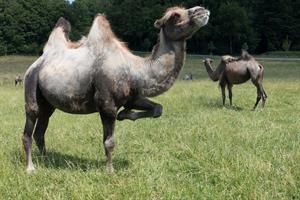PDF chapter test TRY NOW
There are two different kinds of camel. One, known as the Dromedary, has only a single hump; the other is called a Bactrian camel and has two humps. The humps help the animal to survive in the desert, by acting as storage containers. But they don’t store water — as many people wrongly believe — they are full of fat. This fat nourishes the camels when food is scarce. If they have nothing to eat for several days, their humps shrink as the fat is used up. There are many other ways in which camels are adapted to desert life. Their mouths are so tough that even the sharp thorn cannot pierce through.
Explanation:
There are two types of camels, namely:
- The Dromedary
- The Bactrian Camel
The Dromedary has only one hump, while the Bactrian camel has two humps on it. Some humans assume that the hump is full of water. However, it is not so. The hump is actually made up of fat. When the food becomes scarce in the desert, camel uses the stored fat from the hump and nourishes itself. If the camel doesn't have anything to eat for several days, the hump will become smaller. The mouth of the camel is so strong that even sharp thorns can not tear it. All these features help camels adapt to desert life.

This is a Dromedary (Single hump)

This is a Bactrian Camel (Double hump)
Numbers | Words | Meanings |
1. | Scarce | Rare/ Harder to find |
2. | Pierce | An action where a sharp, pointed object tears through any other object |
3. | Hump | A rounded protuberance found on the back of a camel |
4. | Nourishes | Provide with the food or other substances necessary for growth, health, and good condition |
5. | Thorn | A stiff, sharp-pointed on a stem |
6. | Shrink | Become smaller in size |
Reference:
National Council of Educational Research and Training (2006). Honeysuckle. Desert Animals (pp. 112-120). Published at the Publication Division by the Secretary, National Council of Educational Research and Training, Sri Aurobindo Marg, New Delhi.
